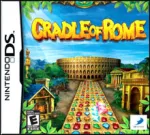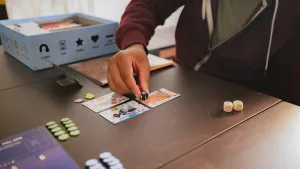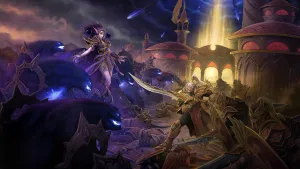Cradle of Rome Review
 Everyone knows Bejeweled, right? You've got a 2D grid with several colors of tiles on it, and the only moves you can make are flipping two adjacent tiles to make sets of three or more of the same color. As those tiles disappear, random tiles fall from the top, and you repeat until time runs out or you hit your score goal. It's a great formula, and like all top-shelf puzzle games, it's been copied ad nauseum. The latest pretender is Cradle of Rome, and let me tell you, it's no Puzzle Quest.
Everyone knows Bejeweled, right? You've got a 2D grid with several colors of tiles on it, and the only moves you can make are flipping two adjacent tiles to make sets of three or more of the same color. As those tiles disappear, random tiles fall from the top, and you repeat until time runs out or you hit your score goal. It's a great formula, and like all top-shelf puzzle games, it's been copied ad nauseum. The latest pretender is Cradle of Rome, and let me tell you, it's no Puzzle Quest.
The twist on the Bejeweled formula here is in the boards. Every one of the dozens of levels has a unique layout, and to pass it you must match tiles on certain spaces, usually all of them. Chains may lock tiles into designated spaces until you make a match using that tile, restricting your available moves until you can free up that tile. Some tiles fill up special power meters rather than scoring points, which allow you to drop bombs, shoot lightning, or the like.
Sounds good so far, right? Sadly, the mechanics only add difficulty and frustration as they get more complex, never becoming much more interesting than the first hour of play. The nature of the gameplay, with random tiles filling in whenever you remove others, prevents any but the most basic strategy from taking hold. The handful of special powers, which you'll use at most two or maybe three times per level, are nothing on the level of Puzzle Quest's dizzying array of spells. Far too often, you'll be reduced to hoping for a particular tile to drop rather than planning a sequence of moves, especially on the harder boards where a single space frequently gates a large section of the level.
Cradle of Rome is far from terrible, but it has neither the strategic depth nor the Pavlovian addiction required to be a worthwhile puzzle game.

Get the Game Informer Print Edition!
Explore your favorite games in premium print format, delivered to your door.
- 10 issues per year
- Only $4.80 per issue
- Full digital magazine archive access
- Since 1991










